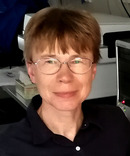Contact
There is growing evidence that spatial organization is the key to genome function. In addition to other epigenetic factors, the arrangement of chromatin within the nucleus is crucial for transcription regulation and for establishing and maintaining of cellular identity during differentiation. In the nucleus, separate chromosomes merge into a seamless chromatin mass but eu- and heterochromatin segregate from each other, which is highly important for proper nuclear functioning (Solovei et al. 2016, PubMed). In our group we study mechanisms of EC and HC segregation, including chromosome folding and tethering to the nuclear scaffolding structures in various cell types. One of our favorite models are nuclei of rod photoreceptors in nocturnal retinas with atypical eu- and heterochromatin arrangement. In conventional nuclei, euchromatin is localized in the nuclear interior and heterochromatin at the nuclear periphery. In nocturnal rods, positions of eu- and heterochromatin are inverted: all heterochromatin is concentrated in the nuclear center, whereas euchromatin forms a thin peripheral shell. This inverted architecture converts rod nuclei into microlenses reducing light scattering in thick retinas and thus facilitating nocturnal vision (Solovei et al. 2009, PubMed)
http://www.bioimaging.bio.lmu.de/research/research-group_solovei/index.html


